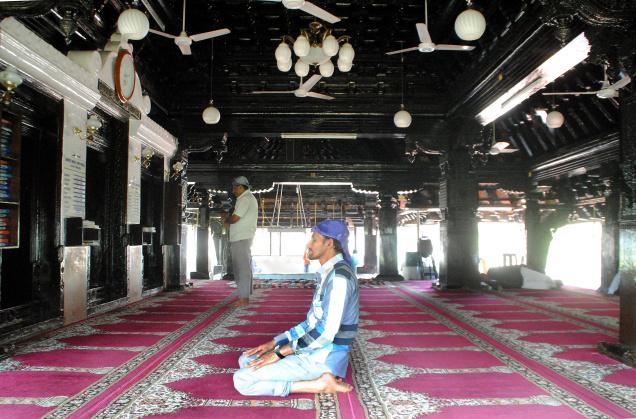
Traffic piles up on the roads as trucks carrying chilies, condiments and fish negotiate the narrow roads of Bunder. However much the chaos outside, the noisy streets and the banes of modernity are sidelined as one enters the unostentatious arch of the Zeenath Baksh Juma Masjid.
Built in 644 A.D. by Malik Deenar, a disciple of Prophet Mohammad, who also set up the mosques in Kasargod and Udupi, the real essence of the present-day mosque is the wooden inner sanctum. A total of 16 teak pillars – even now maintained in pristine condition – line the periphery of the original masjid. Patterns of flowers, bells, and symbols decorate the pillars entirely. A combination of teak and rosewood make up the doors, walls and a thick floor. The structure in its entirety stands testimony to the contributions of the 17 century king Tipu Sultan, who then called it “Zeenath Baksh” translating roughly to place of beauty, said Hanif Ali, Secretary of Central Muslim Committee.
“This is probably the only mosque in the State which is entirely made up of wood. Even the roof is entire wood and covered by a brass sheet to protect it from the rain. Even if the stone walls were removed, the structure would still stand,” he said.
With structures in the city often seen ravaged by the rains, heat and humidity, it is a surprise that the 400-year-old wood carvings of the mosque still carry with it the veneer of freshness.
“Every couple of years, we spend more than Rs. 1 lakh to rub in oil to preserve it. Apart from fixing small scratches, we have not modified or replaced any part of the structure,” said Abdul Rahim, Manager of the Masjid, who added that as the intricate carvings on the pillars and beams were made from one block of wood, there was little chance of nails breaking off or adhesives wearing off.
However, the mosque authorities said that apart from a token fund from the government for maintenance, there was little help in promoting the historical nature of the mosque. “We have written to the tourism department and the Wakf Board to develop the mosque into a tourist spot. They have shown interest, but nothing concrete is being done,” said Mr. Ali.
Similarly, with the mosque being central to the death rituals and burials, the authorities had written to the district administration to grant land for burials.


